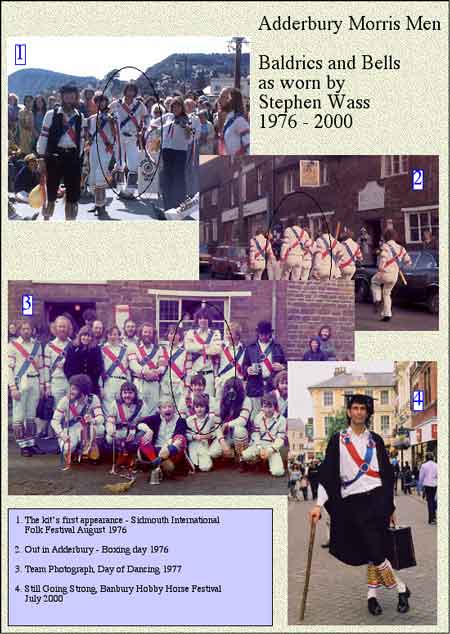The Background…
For those who think morris dancing a quaint survival it is a remarkable fact that there is probably more morris danced today than at any time in its past history! On a Saturday in late April residents and visitors alike are able to watch exponents of North Oxfordshire’s own contribution to ‘World Dance’ performing round the village. It is a great spectacle but why in Adderbury?
A Little History
Morris dancing is a traditional or ‘roots’ dance form which belongs especially to the Midland counties of England. Nobody is quite sure when and where it started but there is no evidence at all to link it with pagan customs or fertility rituals!
Researchers largely believe that it began in Spain in the 12th century as a performance to celebrate the liberation of Spain from Moslem occupation, hence the term ‘Moorish Dancing’. It became popular in the royal courts of Europe and eventually arrived in England as a courtly entertainment in the late 14th century. Eventually it fell out of fashion in Royal circles but was taken up in the 15th and 16th, centuries by civic authorities who included Morris dances in their processions and pageants.
The church was not slow to see the fund raising potential of the spectacle of Morris dancing and many parishes kept their own sets of costumes in church to be brought out for the annual Whitsun Ale celebrations.
By the start of the 17th. century Morris dancing was in decline, a process hastened by the rantings of puritan sects who condemned it because of the associated rowdy behaviour and drunkenness.
At this point it seems to have gone underground and almost vanishes from history for 200 years. In fact Morris dancing had migrated to the rural communities where there were few people to record its passing. Because of the social conditions prevalent at the time dancers were usually male although there are records of female dancers participating too. By the early years of the 20th. century Morris was once again about to transform itself.
During the mid-nineteenth century most local villages would have had their own team of morris dancers performing a programme of dance unique to their community. By the end of the century morris dancing was losing support in the face of competition from other, less demanding, forms of popular entertainment and the carnage of the First World War all but delivered its death blow. Fortunately the tradition was maintained in one or two out of the way places and information about other dances was recorded by early students of folk-lore. In the early years of this revival people got hold of the idea that morris dancing was a survival of some kind of pagan fertility ritual and only danced by men. History reveals no evidence for this at all and the flowering of morris dancing in the twentieth century has seen new teams formed some for men, some for women and some mixed.
Morris around Banbury
There are several reports of Morris dancing in Banbury from years gone by. Puritans in the seventeenth century complained about Morris dancers and their ungodly ways. (Be warned some people still do!) Towards the end of the eighteenth century local teams were recorded at Ayhno, Bicester, Brackley, Croughton, Kings Sutton, Middleton Cheney. During the nineteenth century sides were known to be active in Adderbury, Badby, Bloxham, Brackley ,Bucknell, Deddington, Kings Sutton.
Teams regularly used to dance at Banbury Fair and the well known Banbury eccentric, William ‘Old Mettle’ Castle was fool for the Adderbury team in the last century. During the nineteenth century the village had two or possibly three teams performing although the practice had died out by the 1880’s
In Adderbury the dances were recorded from the last surviving member of the original team, William Walton, in such detail by Janet Blunt and others that the dances could still be performed by newly formed revival teams despite the tradition dying out in Adderbury itself after a brief flourish in the early years of the twentieth century. Adderbury became popular with groups of dancers from as far afield as the United States and Australia.
The Revival
In 1974 the dances came back to Adderbury when the tradition was revived by two local dancers: Tim Radford and Brian Sheppard, who recruited a team, some of whom are still dancing today.
The revival team has now been dancing for over a quarter of a century and as it enters the new millennium it is as strongly supported as ever. It is particularly noted for the near legendary ‘Adderbury Big Band’ sound with a large pool of experienced musicians to draw on. We are particularly pleased at the number of young people who are prepared to put in the effort required to ensure that the team survives for the future. As one of the events marking the millennium a set of kit and the following photographic record were buried in a time capsule within the fabric of St. Mary’s Church Adderbury.

The team tries to maintain a reasonable balance between regular commitments to dancing out and having a life. In that respect we do not do as much as many teams. Our annual calendar begins with stick stripping usually in March in preparation for the day of dance in late April, we very rarely dance between Christmas and then. After the Day of Dance we can often be seen at a range of local traditional events which we support including May Day in Oxford, Whit Monday at Bampton, Kirtlington Lamb Ale, the Banbury Hobby Horse Festival and our charity tour of Stratford. The season has tended to end in October with a performance at the Banbury Folk Festival. Occasionally we take paid bookings and do one or two local fêtes together with the odd pub tour with other local teams.
